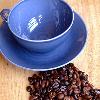

Topics: Health Tags: Caffeine View |
Tags: Caffeine View |
|
|||||||||
Xn) RPhrases = R22 SPhrases = S2 NFPA-H = 2 NFPA-F = 0 NFPA-R = 0 LD50 = 192 mg/kg (rat, oral)
Caffeine is a bitter, white crystalline xanthine alkaloid that is a psychoactive stimulant drug. Caffeine was discovered by a German chemist, Friedrich Ferdinand Runge, in 1819. He coined the term kaffein, a chemical compound in coffee (the German word for which is Kaffee), which in English became caffeine (and changed to Koffein in German).
Caffeine is found in varying quantities in the beans, leaves (leaf), and fruit of some plants, where it acts as a natural pesticide that paralyzes and kills certain insects feeding on the plants. It is most commonly consumed by humans in infusions extracted from the bean (coffee bean) of the coffee plant (Coffea arabica) and the leaves of the tea bush (Camellia sinensis), as well as from various foods and drinks containing products derived from the kola nut. Other sources include yerba mate, guarana berries, and the Yaupon Holly.
In humans, caffeine is a central nervous system (CNS) stimulant, having the effect of temporarily warding off drowsiness and restoring alertness. Beverages containing caffeine, such as coffee, tea, soft drinks, and energy drinks, enjoy great popularity. Caffeine is the worlds most widely consumed psychoactive substance, but, unlike many other psychoactive substances, it is legal and unregulated in nearly all jurisdictions. In North America, 90% of adults consume caffeine daily. The U.S. Food and Drug Administration (Food and Drug Administration (United States)) (FDA) lists caffeine as a "multiple purpose generally recognized as safe food substance".
Caffeine has diuretic properties when administered in sufficient doses to subjects that do not have a tolerance (drug tolerance) for it. Regular users, however, develop a strong tolerance to this effect, and studies have generally failed to support the common notion that ordinary consumption of caffeinated beverages contributes significantly to dehydration.
Watchedfields: changed
Verifiedrevid: 322028927
Imagefilel1: Caffeine.svg
Imagefiler1: Caffeine_3d_structure.png
Imagename: Hybrid skeletal structure of the caffeine molecule
Imagefile2: Caffeine-3D-vdW.png
Iupacname: 1,3,7-trimethyl- 1''H''-purine- 2,6(3''H'',7''H'')-dione
Othernames: 1,3,7-trimethylxanthine, trimethylxanthine, methyltheobromine, 7-methyltheophylline, theine, mateine, guaranine
Section1: Chembox Identifiers
Inchi: 1/C8H10N4O2/c1-10-4-9-6-5(10)7(13)12(3)8(14)11(6)2/h4H,1-3H3
Pubchem: 2519
Iuphar Ligand: 407
Inchikey: RYYVLZVUVIJVGH-UHFFFAOYAW
Casno: 58-08-2
Casno Ref: cascite
Number on List: 200-362-1
Chemspiderid: 2424
Smiles: O=C2N(c1ncn(c1C(=O)N2C)C)C
Rtecs: EV6475000
Drugbank: DB00201
Section2: Chembox Properties
Formula: C8H10N4O2
Molarmass: 194.19 g/mol
Appearance: Odorless, white needles or powder
Density: 1.23 g/cm3, solid
Solubility: 2.17 g/100 ml (25 �C),18.0 g/100 ml (80 �C),67.0 g/100 ml (100 �C)
Meltingpt: nowrap227-228 �C (anhydrous); nowrap234-235 �C (monohydrate)
Boilingpt: 178 �C ''subl. (sublimation (chemistry))''
Pka: ?0.13-1.22
Dipole: 3.64 D (Debye) (calculated)
Section7: Chembox Hazards
Externalmsds: ICSC 0405
Euindex: 613-086-00-5
Euclass: Harmful (



